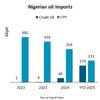Report: Ship Scrapping Growth Could be Good News
Braemar Seascope’s demolition brokers are working extra hard this year, which may be good news
for everyone. Dry cargo demand growth is running at strong levels due to the twin processes of industrialization and urbanization in emerging markets. Annual average demand growth between 2011 and 2015 is likely to match and may even exceed the annual 5.2% growth witnessed between 2004 and 2008 – the years of the superboom in dry cargo vessel earnings. However, the massive amount of vessel ordering during and after the boom has led to the currently epressed freight market for dry bulk carriers. Bulker fleet gross growth (i.e. counting new deliveries but not scrapping) is likely to be in the order of 12% a year until 2013 as we add more than 3,000 newbuildings to the circa 8,100 ships that existed at the end of 2010. But scrapping can make a difference in these markets. In order to bring net fleet growth (i.e. deliveries minus deletions) into line with demand growth expectations, every bulk carrier built before 1985 ‐ nearly 1,500 ships – would have to be scrapped by the end of 2013. This would bring fleet growth down to an average 6.3% a year.
In other words, to return supply and demand growth to balance, the industry must scrap 12 bulk
carriers every week for the next two years and four months without ordering any further bulkers
for delivery before 2014.
The good news is that demolition at these levels is less outlandish than it may seem. According to the Braemar Seascope Demometer, 409 bulk carriers totalling almost 20 million dwt were sold for demolition in 2011 up to the end of August, at a rate of over 11 a week. This amount of scrapping far exceeds previous records of 11.8m dwt in 1999 and 11.2m dwt in 2009. If scrapping continues at this rate for the balance of 2011, some 29m or 30m dwt will be removed from the bulk carrier fleet, offsetting the 85m dwt Braemar Seascope expects to be delivered in 2011.
Braemar Seascope Research Manager Mark Williams, says: “There’s a good chance that bulk carrier
fleet growth can be kept down to 9% this year if these levels of scrapping keep up. We just have to hope that the global economy pulls out of the doldrums and that demand keeps up with
expectations.”














